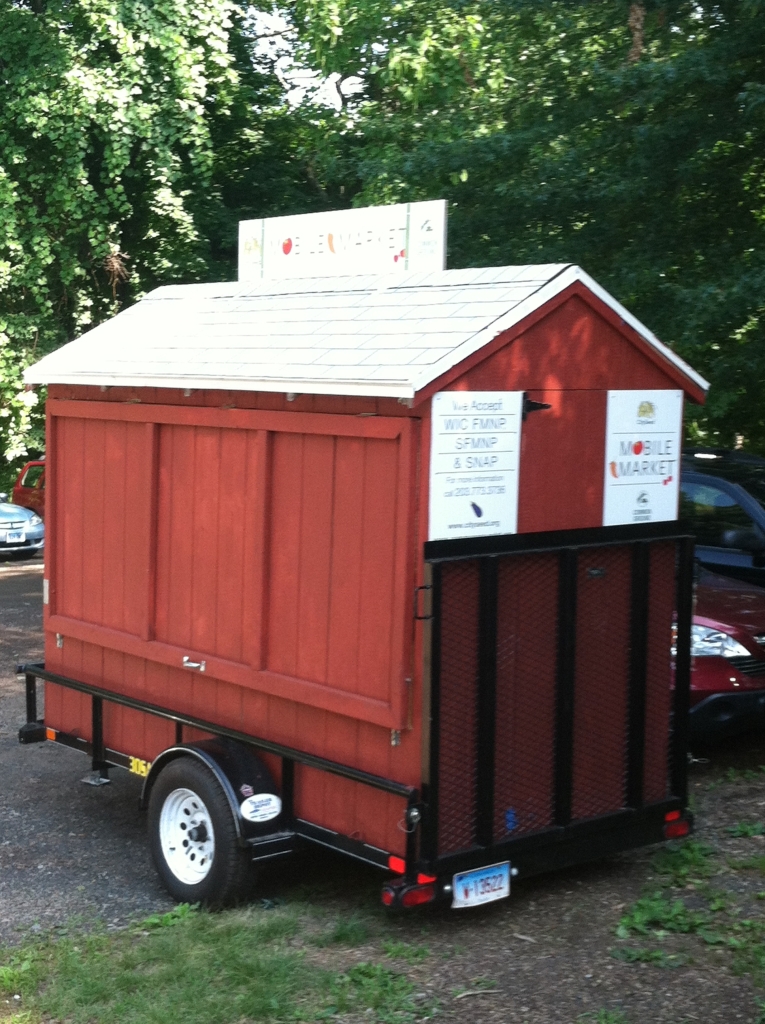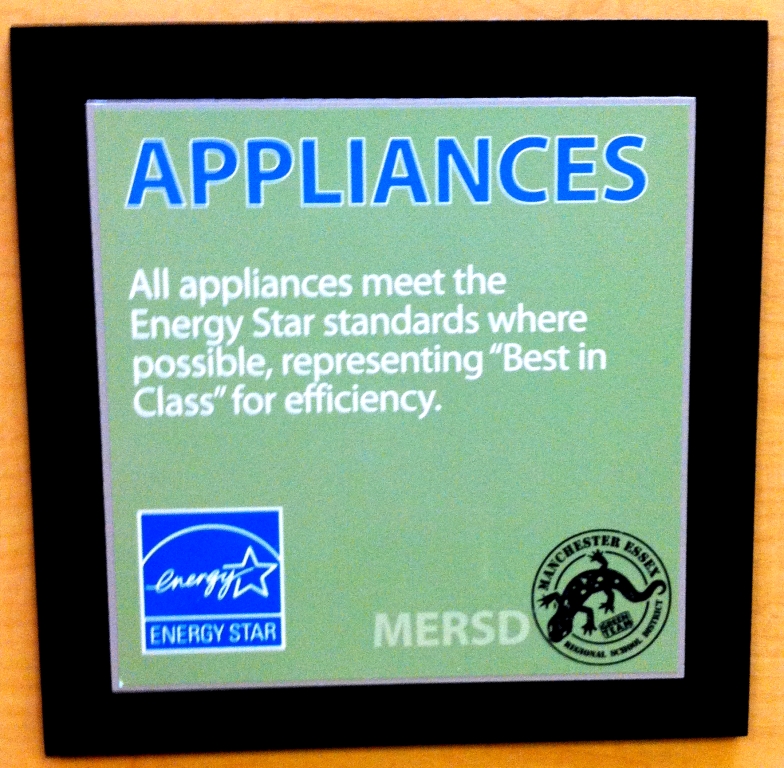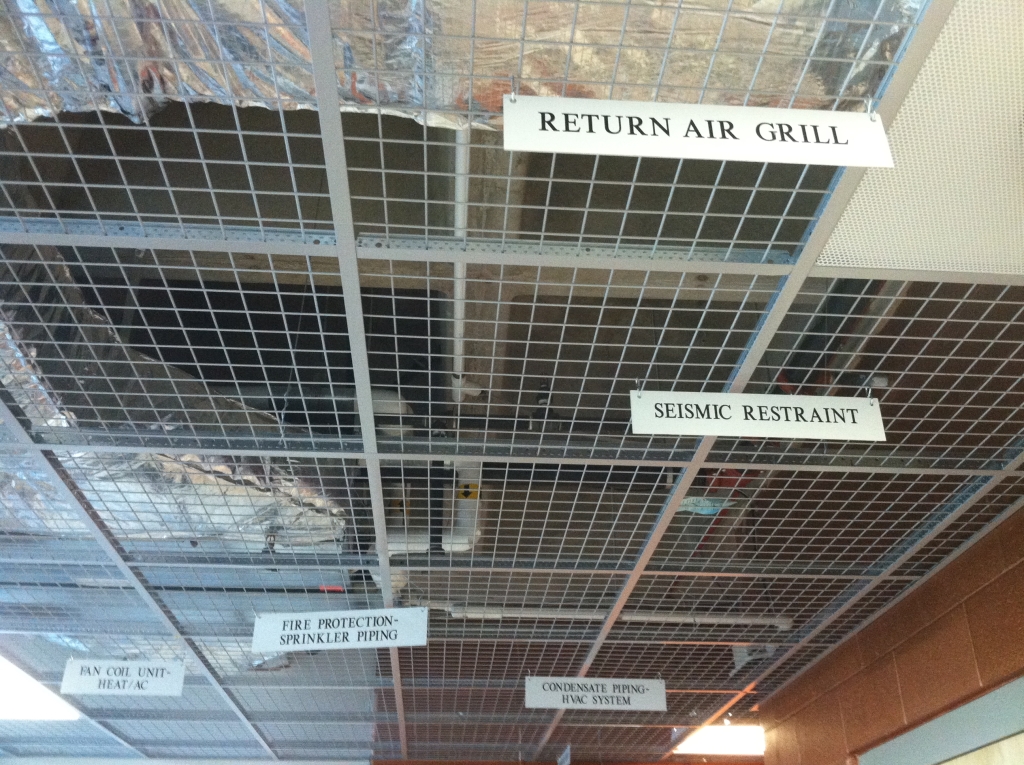By Carolyn Goldthwaite | Mon, August 12, 13
Back to school? Yes please!
I want to go back to school.
Really I do. I’m not talking about masters' degrees or professional development courses. I want to go back to middle or high school.
 Fried lunches are being replaced with fresh vegetables!
I never thought this would be something that would come out of my mouth. Not that school was bad – it’s more that I have had enough algebra to last a lifetime (not to mention I wasn't very good at it.) It’s more about the unbelievably progressive sustainability initiatives schools are taking on.
Last week I participated in the New England ‘Education Built to Last’ Facilities Best Practice Tour and I learned that some schools are teaching math by growing vegetables. As a visual learner, this is something I could understand. Touring these schools made me want to go back.
The tour featured schools that have been recognized by the U.S. Department of Education’s Green Ribbon Program. The program awards schools for implementing a strong, holistic approach to being "green".
It consists of three pillars:
I. Reduced Environmental Impact and Costs
II. Improved Health and Wellness
III. Effective Environmental and Sustainability Education
The tour of these 7 schools kicked off in Rhode Island at the Providence Career and Technical Academy (PCTA) “Where else but a small state can you have the Governor, Mayor and both Senators showing up,” said Senator Sheldon Whitehouse.
In his opening remarks, Senator Whitehouse said, "Rhode Island is a good environment for new ideas, we have a capacity for nimbleness. We have to keep the pressure on and focus on our schools. Lack of maintaining our schools sends the wrong message to students - it’s what matters. Green schools are better for the kids and cheaper to run, they create jobs."
I couldn’t agree with him more.
So, how can we ensure that schools keep up with a more sustainable-minded time and take their students along for the ride with them? I believe it is through sound energy efficiency policy. Policies that focus on the entire life of the school, not just the construction of the school.
In 2007 Rhode Island made a commitment to their schools when it rewrote its school construction regulations which not only requires Northeast Collaborative for High Performance Schools (NE-CHPS )for new construction or major renovations but also require all facilities' operators to be trained or certified. This ensures that these facilities operate as healthy, productive, energy efficient schools.
Every school participating in this tour left me reminiscing of my childhood schooling days. PCTA students told us about problem solving the challenge of what to do with their skateboards – they don’t fit in the lockers. The students are assisting in designing and building of new lockers that allocate space for skateboards.
Imagine having that level of input, as a student, into the infrastructure of your school?
The Barnard Environmental Studies school in New Haven, CT grows its own stock of vegetables and highlights their partnership with a local kale chip company in the student’s curriculum. The students assist in the growing and selling of their school’s kale to the local economy.
Wait, it gets better.
They’ve tied it to science and math curriculum as well – they grow the vegetables using a method called square foot gardening. You have X number of seeds and only Y amount of space. It requires careful calculations and planning.
Fried lunches are being replaced with fresh vegetables!
I never thought this would be something that would come out of my mouth. Not that school was bad – it’s more that I have had enough algebra to last a lifetime (not to mention I wasn't very good at it.) It’s more about the unbelievably progressive sustainability initiatives schools are taking on.
Last week I participated in the New England ‘Education Built to Last’ Facilities Best Practice Tour and I learned that some schools are teaching math by growing vegetables. As a visual learner, this is something I could understand. Touring these schools made me want to go back.
The tour featured schools that have been recognized by the U.S. Department of Education’s Green Ribbon Program. The program awards schools for implementing a strong, holistic approach to being "green".
It consists of three pillars:
I. Reduced Environmental Impact and Costs
II. Improved Health and Wellness
III. Effective Environmental and Sustainability Education
The tour of these 7 schools kicked off in Rhode Island at the Providence Career and Technical Academy (PCTA) “Where else but a small state can you have the Governor, Mayor and both Senators showing up,” said Senator Sheldon Whitehouse.
In his opening remarks, Senator Whitehouse said, "Rhode Island is a good environment for new ideas, we have a capacity for nimbleness. We have to keep the pressure on and focus on our schools. Lack of maintaining our schools sends the wrong message to students - it’s what matters. Green schools are better for the kids and cheaper to run, they create jobs."
I couldn’t agree with him more.
So, how can we ensure that schools keep up with a more sustainable-minded time and take their students along for the ride with them? I believe it is through sound energy efficiency policy. Policies that focus on the entire life of the school, not just the construction of the school.
In 2007 Rhode Island made a commitment to their schools when it rewrote its school construction regulations which not only requires Northeast Collaborative for High Performance Schools (NE-CHPS )for new construction or major renovations but also require all facilities' operators to be trained or certified. This ensures that these facilities operate as healthy, productive, energy efficient schools.
Every school participating in this tour left me reminiscing of my childhood schooling days. PCTA students told us about problem solving the challenge of what to do with their skateboards – they don’t fit in the lockers. The students are assisting in designing and building of new lockers that allocate space for skateboards.
Imagine having that level of input, as a student, into the infrastructure of your school?
The Barnard Environmental Studies school in New Haven, CT grows its own stock of vegetables and highlights their partnership with a local kale chip company in the student’s curriculum. The students assist in the growing and selling of their school’s kale to the local economy.
Wait, it gets better.
They’ve tied it to science and math curriculum as well – they grow the vegetables using a method called square foot gardening. You have X number of seeds and only Y amount of space. It requires careful calculations and planning.
 The Common Ground High School keeps its very own goat on campus.
The Common Ground High School, also in New Haven, has a similar program. They grow 7,000lbs of organic food each year for their school. They sell the excess. Not only do they have a stand at the school but they also have a mobile cart to bring to different markets. When the school was built they were (and still are) working with a limited budget that focuses on common-sense, affordable sustainability practices. Practices that include daylighting, operable windows and passive heating and cooling − to top it off they even have a goat!
I’m sure you've heard a picture is worth a thousand words. Well what about a sign? While the gardens were a common theme of the tours, another prevalent theme was educational signage.
The Common Ground High School keeps its very own goat on campus.
The Common Ground High School, also in New Haven, has a similar program. They grow 7,000lbs of organic food each year for their school. They sell the excess. Not only do they have a stand at the school but they also have a mobile cart to bring to different markets. When the school was built they were (and still are) working with a limited budget that focuses on common-sense, affordable sustainability practices. Practices that include daylighting, operable windows and passive heating and cooling − to top it off they even have a goat!
I’m sure you've heard a picture is worth a thousand words. Well what about a sign? While the gardens were a common theme of the tours, another prevalent theme was educational signage.
 Educational signs are rampant in these high performance schools.
It's everywhere, in different forms including electronic kiosks that explain sustainable elements of the school ( like the amount of PV energy the school can produce), school construction diagrams, materials used, associated energy savings and the important roles occupants can take to keep these schools at their peak level of performance.
I would have loved to attend class in one of these forward-leaning schools as an elementary student. I often wondered how things worked, imagining the world behind the walls. These schools would have aided my curiosity and given me some answers.
Educational signs are rampant in these high performance schools.
It's everywhere, in different forms including electronic kiosks that explain sustainable elements of the school ( like the amount of PV energy the school can produce), school construction diagrams, materials used, associated energy savings and the important roles occupants can take to keep these schools at their peak level of performance.
I would have loved to attend class in one of these forward-leaning schools as an elementary student. I often wondered how things worked, imagining the world behind the walls. These schools would have aided my curiosity and given me some answers.
 30 schools, representing 11 states in NEEP’s region, were recognized as Green Ribbon Schools this year. To find out more about the program, take a look here. You can also check out our resources page to put your school on the path to saving energy and getting a Green Ribbon!
30 schools, representing 11 states in NEEP’s region, were recognized as Green Ribbon Schools this year. To find out more about the program, take a look here. You can also check out our resources page to put your school on the path to saving energy and getting a Green Ribbon!
 Bringing pegged pants back into style!
Touring these schools was truly inspiring; it made me want to go back to school so, excuse me, I’ve got to go pick out my first day of school outfit.
Are pegging your pants still in?
They are now!
New England ‘Education Built to Last’ Facilities Best Practice Schools:
Connecticut
Bringing pegged pants back into style!
Touring these schools was truly inspiring; it made me want to go back to school so, excuse me, I’ve got to go pick out my first day of school outfit.
Are pegging your pants still in?
They are now!
New England ‘Education Built to Last’ Facilities Best Practice Schools:
Connecticut
 Fried lunches are being replaced with fresh vegetables!
Fried lunches are being replaced with fresh vegetables! The Common Ground High School keeps its very own goat on campus.
The Common Ground High School keeps its very own goat on campus. Educational signs are rampant in these high performance schools.
Educational signs are rampant in these high performance schools. 30 schools, representing 11 states in NEEP’s region, were recognized as Green Ribbon Schools this year. To find out more about the program, take a look here. You can also check out our resources page to put your school on the path to saving energy and getting a Green Ribbon!
30 schools, representing 11 states in NEEP’s region, were recognized as Green Ribbon Schools this year. To find out more about the program, take a look here. You can also check out our resources page to put your school on the path to saving energy and getting a Green Ribbon!
 Bringing pegged pants back into style!
Bringing pegged pants back into style!- Barnard Environmental Studies Magnet School New Haven, CT
- Environmental Sciences Magnet School at Mary Hooker Hartford, CT
- Common Ground High School New Haven, CT
- Manchester Essex Regional Middle High School Manchester-by-the-Sea, MA
- Quincy High School Quincy, MA
